SPRING MUSHROOMS
There are over 100 fairly common spring mushrooms in our area (NYC metro area) – that is, occurring between March 21 and June 21. Some of these occur in great numbers. Some are choice edibles. A few are poisonous. One is deadly. Most are just not edible or palatable 0r chewable. Learn them one at a time and you’ll see how quickly you can become familiar with much of our spring mushroom flora…………..
——————————————————-
CENTRAL PARK MUSHROOM HUNT – JUNE 14th
GILLED MUSHROOMS included AMANITA flavorubescens PLUTEUS cervinus, PSATHYRELLA candolleana, RUSSULA sp., SCHIZOPHYLLUM commune, STROPHARIA rugosoannulata, and a few still to be identified
NON-GILLED MUSHROOMS included: XYLARIA polymorpha, STEREUM ostrea, PHELLINUS robiniae, GANODERMA curtisii, USTULINA deusta, and others…….
———————————————————
The mushrooms below are arranged in two large groups – ASCOMYCETES and BASIDIOMYCETES.
The ASCOMYCETES include the CUP FUNIG, the MORELS, the DEAD MAN’S FINGERS and BLACK KNOT OF CHERRY
The BASIDIOMYCETES include the POLYPORES, the GILLED MUSHROOMS, the BOLETES, the JELLY FUNGI, and the PUFFBALLS
Below the photographs of spring mushrooms, there is a TEST that you can take. See how well you do. (Answers will follow in a June posting).
———————————————————-
ASCOMYCETES
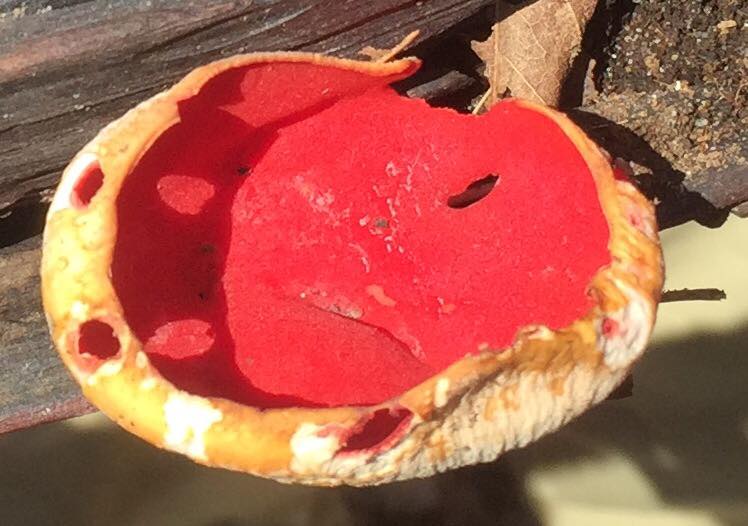
CUP FUNGUS – Sarcoscypha coccinea – not edible – on sticks on the ground near ponds or lakes
————————————————————-

MORELS – Morchella esculenta (americana) – Choice Edible – on the ground under old elms, apple trees, tulip poplar
————————————————————-

Immature DEAD MAN’S FINGERS – Xylaria polymorpha – not edible – at the base of hardwood trees, often apple or crabapple
————————————————————-
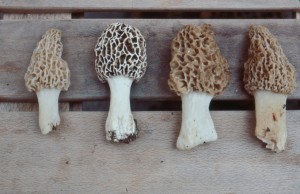
BLACK KNOT OF CHERRY – Apiosporina morbosa – not edible – parasitic, on cherry branches
————————————————————-
BASUDUINTCETES
POLYPORES

DRYAD’S SADDLE (PHEASANT BACK) – Polyporus squamosus – good edible when young – on wood
————————————————————-
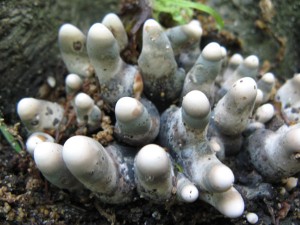
CHICKEN MUSHROOM – Laetiporus sulphureus – CHOICE EDIBLE MUSHROOM – on wood of hardwood trees – fruiting from May through October
————————————————————-
GILLED MUSHROOMS
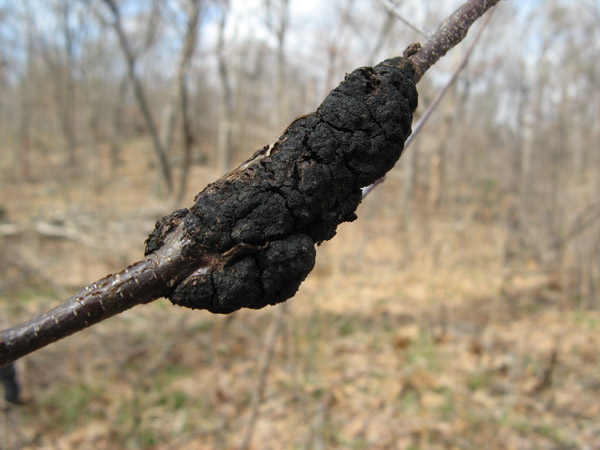
PLAYGROUND MUSHROOM – Agaricus bitorquis – choice edible – on the ground, often bare ground, grassy areas, wood chips, etc.
————————————————————-

OYSTER MUSHROOM – Pleurotus ostreatus – Choice edible – on wood
————————————————————
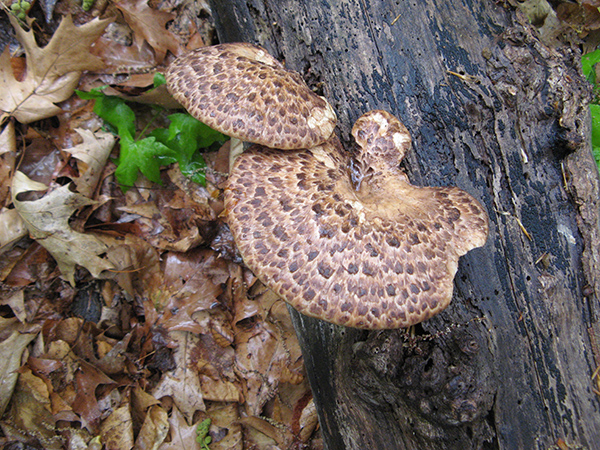
DUNCE CAP – Conocybe lactea – not edible – common in grass in late May/early June
———————————————————-
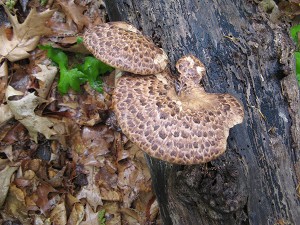
LAWN MOWER’S MUSHROOM – Panaeolina foenisecii – not edible – common in grass in late May/early June
———————————————-
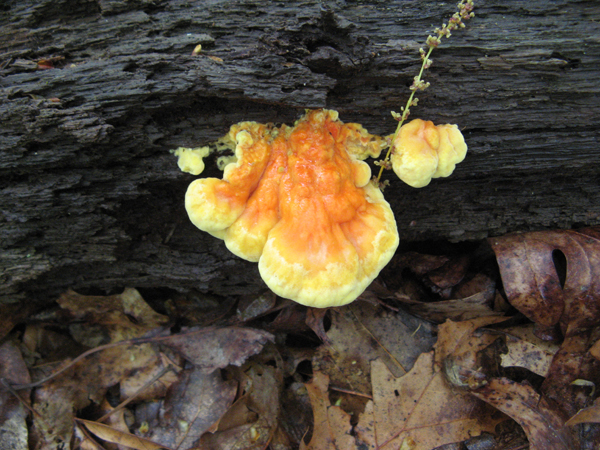
Baby INKY CAPS – Coprinus macaques complex – Edible, good in soup, as duxelles, etc. – on wood, base of stumps, wood chips
————————————————————-
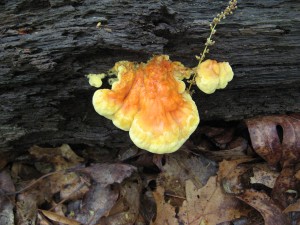
DEADLY GALERINA – Galerina (autumnalis) marginata – a very common Little Brown Mushroom – on decayed logs – DEADLY POISONOUS
—————————————————————
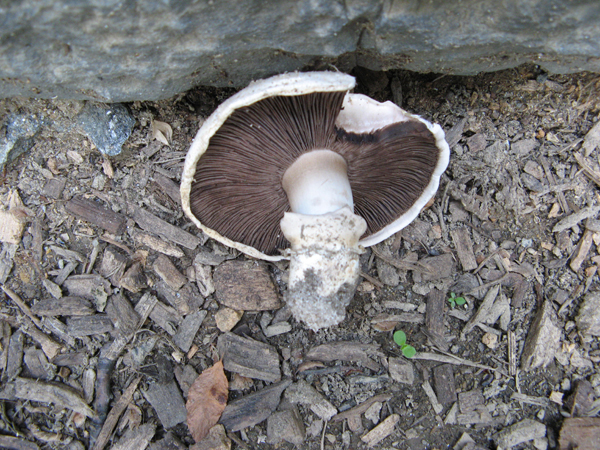
FAWN MUSHROOM – Pluteus cervinus complex – edible when young – on wood or buried wood
————————————————————-
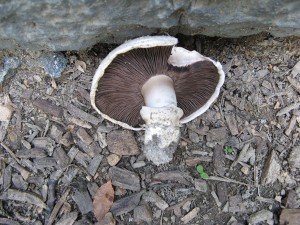
WINE CAP – Stropharia rugosoannulata – Good edible when young – always in wood chips
————————————————————
BOLETES
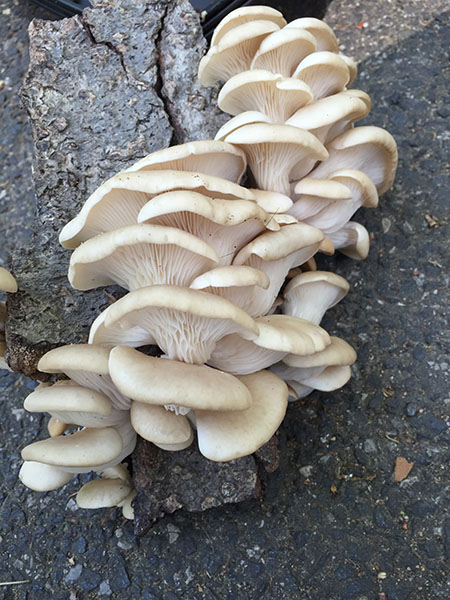
CRACKED CAP BOLETE – Xerocomellus chrysenteron – first bolete to appear (late May-early June) – edible – on the ground under oaks (mycorrhizal)
—————————————————————
JELLY FUNGI
WOOD-EAR – Auricularia auricula complex – edible, best in soup – one wood – common in late winter and spring
—————————————————————-
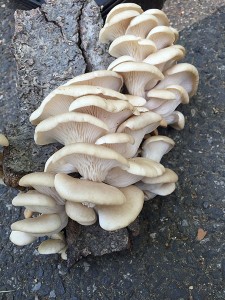
WITCHES’ BUTTER – Tremella mesenteric complex – edible but not incredible – on wood
———————————————————————-
SPRING MUSHROOMS 2017………………SPRING MUSHROOMS 2017…………………SPRING MUSHROOMS 2017
A MULTIPLE CHOICE TEST –
1, Name 3 gilled mushrooms that grow on wood: a) Agaricus bitorquis, b) Pleurotus ostreatus, c) Coprinus micaceus, d) Morchella esculenta, e) Flammulina velutipes, f) Ganoderma applanatum
2. Name 3 gilled mushrooms that grow on the ground: a) Agaricus bitorquis, b) Pleurotus ostreatus, c) Conocybe lactea, d) Panaeolina foenisecii, e) Pluteus cervinus, f) Stropharia rugoso-annulata
3. What color is the spore print of Pluteus cervinus: a) white, b) yellowish, c) pinkish brown or brownish pink, d) ochre brown, e) purple brown, f) black
4. Name one deadly Little Brown Mushroom: a) Agaricus bitorquis, b) Pleurotus ostreatus, c) Gallerina autumnalis (marginata) , d) Morchella esculenta, e) Pluteus cervinus, f) Flammulina velutipes
5. Name one spring lawn mushroom: a) Pluteus cervinus, b) Flammulina velutipes, c) Stropharia rugoso-annulata, d) Marasmius oreades, e) Morchella esculenta, f) Pleurotus ostreatus
6. Name one inky cap mushroom that is not safe to eat: a) Coprinus comatus, b) Coprinus micaceus, c) Coprinus atramentarius, d) Coprinus plicatilis, e) Coprinus disseminatus
7. What’s the name of the common cultivated mushrooms?: a) Agaricus campestris, b) Agaricus bitorquis, c) Agaricus bisporus, d) Agaricus arvensis, e) Agaricus placomyces
8. Name one spring species of Agaricus: a) Agaricus arvensis, b) Agaricus bitorquis, c) Agaricus crocodilians, d), Agaricus placomyces, e) Agaricus bernaradii
9. Where would I look to find Wine Cap mushrooms?: a) in lawns, b) on trees, c) in wood chip mulch, d) in manure, e) in deep conifer woods
10. Where would I look to find oyster mushrooms: a) in a lawn, b) in swampy ground, c) on trees and logs, d) in manure, e) on other mushrooms
11. Name one common spring polypore: a) Polyporus squamnosus, b) Grifola frondosa, c) Meripilus sumstinei
12. Where should I look to find morels? a) on elm trees, b) under elm trees, c) in manure piles, d) in swamps, e) only at Whole Foods
13. How can I tell a morel from a false morel?: a) only one is brown, b) only one comes up in the spring, c) only one has a hollow stem, d) only one smells like cherry vanilla, e) only one is an Ascomycete
14. Have you ever eaten wood-ear mushrooms? a) yes or b) no ????
15. What kind of mushroom is a Turkey-tail?: a) a jelly fungus, b) a gilled mushroom, c) a polypore, d) an Ascomycete, e) a puffball
16. What kind of mushroom is a Reishi mushroom?: a) a gilled mushroom, b) a polypore, c) a jelly fungus, d) an Ascomycete, e) a puffball
17. Where would I look to find Chaga?: a) on an elm, b) on an oak, c) on a birch, d) on a pine, e) on a tulip-poplar
18. What is a Caterpillar Fungus, and is it edible?: Cordyceps is the traditional genus for these mushrooms that parasitize overwintering caterpillars, and it is edible but primarily used as a medicine
19. Where would I look to find Black Knot fungus?: a) on an elm tree, b) on an oak tree, c) on a cherry tree, d) on a poplar tree, e) on a ginkgo tree
20. Are mushrooms edible raw, and if not, why not?: NO (if very few exceptions, mushrooms are highly indigestible raw)
21. Give one example of one ectomycorrhizal mushroom?: a) Coprinus commatus, b) Agaricus bitorquis, c) Pleurotus osteratus, d) Pluteus cervinus, e) Boletus chrysenteron








































